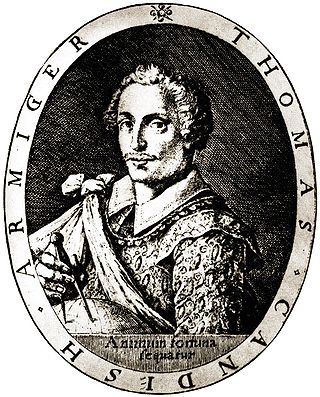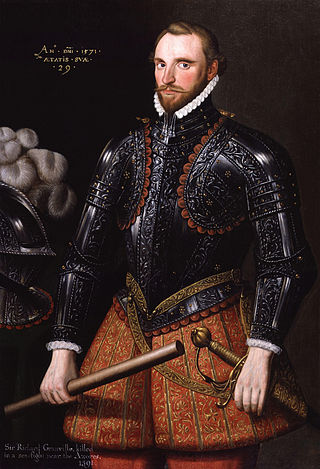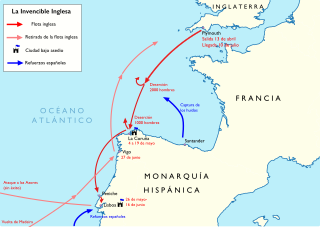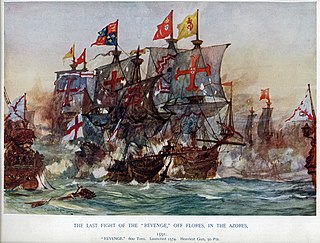
Sir Francis Drake was an English explorer and privateer best known for his circumnavigation of the world in a single expedition between 1577 and 1580. This was the first English circumnavigation, and third circumnavigation overall. He is also known for participating in the early English slaving voyages of his cousin, Sir John Hawkins, and John Lovell. Having started as a simple seaman, in 1588 he was part of the fight against the Spanish Armada as a vice-admiral.

Sir Thomas Cavendish was an English explorer and a privateer known as "The Navigator" because he was the first who deliberately tried to emulate Sir Francis Drake and raid the Spanish towns and ships in the Pacific and return by circumnavigating the globe. Magellan's, Loaisa's, Drake's, and Loyola's expeditions had preceded Cavendish in circumnavigating the globe. His first trip and successful circumnavigation made him rich from captured Spanish gold, silk and treasure from the Pacific and the Philippines. His richest prize was the captured 600-ton sailing ship the Manila Galleon Santa Ana. He was knighted by Queen Elizabeth I of England after his return. He later set out for a second raiding and circumnavigation trip but was not as fortunate and died at sea at the age of 31.

Galleons were large, multi-decked sailing ships developed in Portugal and Spain and first used as armed cargo carriers by Europeans from the 16th to 18th centuries during the age of sail and were the principal vessels drafted for use as warships until the Anglo-Dutch Wars of the mid-1600s. Galleons generally carried three or more masts with a lateen fore-and-aft rig on the rear masts, were carvel built with a prominent squared off raised stern, and used square-rigged sail plans on their fore-mast and main-masts.

Sir Richard Grenville, also spelt Greynvile, Greeneville, and Greenfield, was an English privateer and explorer. Grenville was lord of the manors of Stowe, Cornwall and Bideford, Devon. He subsequently participated in the plantations of Ireland specifically the Munster plantations, the English colonisation of the Americas and the repulse of the Spanish Armada.
Thirteen warships of the Royal Navy have been named HMS Revenge:

The English Armada, also known as the Counter Armada or the Drake–Norris Expedition, was an attack fleet sent against Spain by Queen Elizabeth I of England that sailed on 28 April 1589 during the undeclared Anglo-Spanish War (1585–1604) and the Eighty Years' War. Led by Sir Francis Drake as admiral and Sir John Norris as general, it failed to drive home the advantage that England had gained resulting from the failure of the Spanish Armada in the previous year. The Spanish victory marked a revival of Philip II's naval power through the next decade.

The naval Battle of Vila Franca do Campo, also known as Battle of Ponta Delgada and Naval Battle of Terceira Island, took place on 26 July 1582, off the coast of the island of São Miguel in the Portuguese archipelago of the Azores, during the War of the Portuguese Succession. A combined corsair expedition, mainly French, sailed against a Spanish naval force made up of Portuguese and Castilian ships, to preserve control of the Azores under the pretender António, Prior of Crato and to defend the islands from incorporation into the Iberian Union, the largest French force sent overseas before the age of Louis XIV.

The Spanish Armada was a Spanish fleet that sailed from Lisbon in late May 1588, commanded by the Alonso de Guzmán, Duke of Medina Sidonia, an aristocrat without previous naval experience appointed by Philip II of Spain. His orders were to sail up the English Channel, join with the Duke of Parma in Flanders, and escort an invasion force that would land in England and overthrow Elizabeth I. Its purpose was to reinstate Catholicism in England, end support for the Dutch Republic, and prevent attacks by English and Dutch privateers against Spanish interests in the Americas.
The Spanish Armada in Ireland refers to the landfall made upon the coast of Ireland in September 1588 of a large portion of the 130-strong fleet sent by Philip II to invade England.

The Sea Dogs were a group of English privateers and explorers authorised by Queen Elizabeth I to raid England's enemies, whether they were formally at war with them or not. Active from 1560 until Elizabeth's death in 1603, the Sea Dogs primarily attacked Spanish targets both on land and at sea, particularly during the Anglo-Spanish War. Members of the Sea Dogs, including Sir John Hawkins and Sir Francis Drake, also engaged in illicit slave trading with Spanish colonies in the Americas.

The Battle of Berlengas Islands was a naval battle which took place off the Portuguese coast on 15 July 1591, during the war between Elizabeth I of England and Philip II of Spain. It was fought between an English privateer squadron under George Clifford, 3rd Earl of Cumberland, who had set out his fortunes by large-scale privateering, and a squadron of 5 Spanish galleys commanded by Francisco Coloma tasked with patrolling the Portuguese coast against privateers. While anchored off the Berlengas, the English ships were surprised by the Spanish galleys, which succeeded in taking one English ship and rescuing two prizes.

The Battle of Flores was a naval engagement during the Brittany Campaign of the Anglo-Spanish War of 1585 fought off the Island of Flores between an English fleet of 22 ships under Lord Thomas Howard and a Spanish fleet of 55 ships under Alonso de Bazán. Sent to the Azores to capture the annual Spanish treasure convoy, when a stronger Spanish fleet appeared off Flores, Howard ordered his ships to flee to the north, saving all of them except the galleon Revenge commanded by Admiral Sir Richard Grenville.
The San Juan de Sicilia was one of the 130 ships that formed the ill-fated Spanish Armada of 1588. The ship was originally known as the Brod Martolosi, before it was seized to form part of the navy. It was one of 10 ships forming the Levant squadron, one of 8 squadrons that formed the entire armada.
Don Martín de Bertendona was an important officer of the Spanish Navy under Philip II and Philip III. He participated in the Spanish Armada, and had a role in the capture of the iconic English galleon Revenge in 1591.

The 3rd Spanish Armada, also known as the Spanish Armada of 1597, was involved in a major naval event that took place between 18 October and 15 November 1597 as part of the Anglo–Spanish War. The attack of the armada, which was the third attempt by Spain to invade or raid the British Isles during the war, was ordered by King Philip II of Spain in revenge for the English attack on Cadiz following the failure of the 2nd Spanish Armada the previous year due to a storm. The Armada was executed by the Adelantado, Martín de Padilla, who was hoping to intercept and destroy the English fleet under Robert Devereux the 2nd Earl of Essex as it returned from the failed Azores expedition. When this was achieved, the Armada would go on to capture either the important port of Falmouth or Milford Haven and use those places as a base for invasion.

The action off Bermuda, also known as Grenville's action off the Bermuda's, was a minor naval engagement that took place off the island of Bermuda over three days in late August 1585 during the Anglo–Spanish War between an English galleass, Tiger, and a larger Spanish galleon, Santa Maria de San Vicente. Tiger was victorious when the Spanish ship surrendered after a severe bombardment.

Dainty was an English race-built galleon that began to be built in 1588. The original name was Repentance, but this was soon changed. It participated in some naval engagements in the Anglo-Spanish War (1585–1604). In 1593 it sailed from England under Richard Hawkins to navigate the Pacific Ocean and circumnavigate the world, but was captured the following year by the Spaniards when it was sailing off the coast of what is now Ecuador. It was commissioned by the Spaniards as Nuestra Señora de la Visitación, serving in the South Pacific for several years.

Thomas Cavendish's circumnavigation was a voyage of raid and exploration by English navigator and sailor Thomas Cavendish which took place during the Anglo–Spanish War between 21 July 1586 and 9 September 1588. Following in the footsteps of Francis Drake who circumnavigated the globe, Thomas Cavendish was influenced in an attempt to repeat the feat. As such it was the first deliberately planned voyage of the globe.
Marmaduke was a 40-gun fourth rate vessel of the Kingdom of England, Her initial commission was as a Royalist vessel during the English Civil War named Revenge. She defected to the Parliamentarians then commissioned as Marmaduke. During the First Anglo-Dutch War she partook in the Battle of The Gabbard. During the Second Anglo-Dutch War she participated in the Four Days' Fight. She was scuttled during the Dutch raid on the Medway and sold in 1669.
















